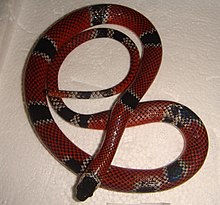Scaphiodontophis: Difference between revisions
Content deleted Content added
m –{{Snake-stub}}, +{{Colubrid-stub}} using StubSorter |
Pvmoutside (talk | contribs) |
||
| (One intermediate revision by the same user not shown) | |||
| Line 11: | Line 11: | ||
==Species== |
==Species== |
||
The following two [[species]] are recognized as being valid.<ref name=RDB/> |
The following two [[species]] are recognized as being valid.<ref name=RDB/> |
||
*''[[Scaphiodontophis annulatus]]'' <small>([[André Marie Constant Duméril|A.M.C. Duméril]], [[Gabriel Bibron|Bibron]] & [[Auguste Duméril|A.H.A. Duméril]], 1854)</small> |
*''[[Scaphiodontophis annulatus]]'' <small>([[André Marie Constant Duméril|A.M.C. Duméril]], [[Gabriel Bibron|Bibron]] & [[Auguste Duméril|A.H.A. Duméril]], 1854)</small> – Guatemala neckband snake |
||
*''[[Scaphiodontophis venustissimus]]'' <small>(Günther, 1893)</small> |
*''[[Scaphiodontophis venustissimus]]'' <small>(Günther, 1893)</small> – common neckband snake |
||
==References== |
==References== |
||
| Line 23: | Line 23: | ||
{{Taxonbar|from=Q2695036}} |
{{Taxonbar|from=Q2695036}} |
||
[[Category: |
[[Category:Scaphiodontophis]] |
||
[[Category:Snake genera]] |
[[Category:Snake genera]] |
||
Latest revision as of 21:20, 31 May 2022
| Scaphiodontophis | |
|---|---|

| |
| Scaphiodontophis venustissimus | |
| Scientific classification | |
| Domain: | Eukaryota |
| Kingdom: | Animalia |
| Phylum: | Chordata |
| Class: | Reptilia |
| Order: | Squamata |
| Suborder: | Serpentes |
| Family: | Colubridae |
| Subfamily: | Sibynophiinae |
| Genus: | Scaphiodontophis Taylor & H.M. Smith, 1943 |
Scaphiodontophis is a genus of snakes in the family Colubridae.[1] The genus is native to Mexico, Central America, and Colombia.
Species[edit]
The following two species are recognized as being valid.[1]
- Scaphiodontophis annulatus (A.M.C. Duméril, Bibron & A.H.A. Duméril, 1854) – Guatemala neckband snake
- Scaphiodontophis venustissimus (Günther, 1893) – common neckband snake
References[edit]
- ^ a b Genus Scaphiodontophis at The Reptile Database www.reptile-database.org.
Further reading[edit]
- Taylor EH, Smith HM (1943). "A Review of the American Sibynophine Snakes, with the Proposal of a New Genus". University of Kansas Science Bulletin 29: 301–337. (Scaphiodontophis, new genus, pp. 302–303).
